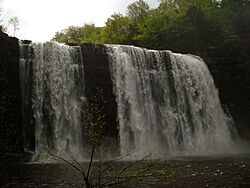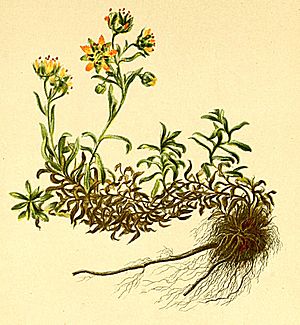Salmon River Falls facts for kids
Quick facts for kids Salmon River Falls |
|
|---|---|

Salmon River Falls, May 2009.
|
|
| Lua error in Module:Infobox_mapframe at line 185: attempt to index field 'wikibase' (a nil value). | |
| Location | Salmon River Falls Unique Area, Oswego County, NY, U.S. |
| Coordinates | 43°32′52″N 75°56′27″W / 43.5478478°N 75.9407509°W |
| Type | Ledge |
| Elevation | 741 feet (226 m) |
| Total height | 110 feet (34 m) |
| Watercourse | Salmon River |
The Salmon River Falls is a beautiful 110-foot (34 m) waterfall located on the Salmon River in Oswego County, New York. It's about 15 miles from where the river meets Lake Ontario. The falls are part of the 112-acre (0.45 km2) Salmon River Falls Unique Area, which is looked after by the New York State Department of Environmental Conservation. This special area is open to everyone and is a very popular place to visit in the region.
Contents
History of Salmon River Falls
Who Lived Near the Falls?
Long ago, before Europeans arrived, Native American tribes like the Onondaga, Oneida, and Cayuga (who were part of the Iroquois Confederacy) used the Salmon River Falls area. They came here to fish for Atlantic salmon. The falls acted like a natural barrier, stopping the salmon from swimming further upstream.
Early Visitors and Changes
In the early 1800s, roads started to reach the thick forests around the falls. This allowed the first sightseers to visit. People also enjoyed fishing for salmon here before these fish disappeared from the river in 1872.
A place called The Cataract House, which was a lodge and dancing spot, operated near the falls between 1860 and 1888. Later, in 1896, a small stand sold food and souvenirs. At that time, some people also called the falls "High Falls."
How Dams Changed the Falls
The Salmon River changed a lot in the early 1900s. This was because hydroelectric dams and their reservoirs were built. Between 1912 and 1930, dams were constructed both above and below the falls. A very long pipeline, about 10,000-foot (3,000 m), was also built to bypass the Salmon River Falls.
Because of this pipeline, less water flowed over the falls. This made them less appealing for visitors. During this time, the Salmon River Power Company owned the falls and the land around them. This company later became part of Niagara Mohawk.
Protecting the Falls Today
In 1993, the ownership of the falls was given to New York State. Starting in 1996, more water was allowed to flow over the falls. Since then, the area has been improved with parking lots, trails that are easy for wheelchairs, and signs that explain the history and nature of the area.
To keep visitors safe, fences were put up near the edges of the gorge. Also, people are not allowed within 15 feet (4.6 m) of the falls' edge. Even with these rules, there have been some accidents at the falls over the years.
Visiting Salmon River Falls Unique Area
The Salmon River Falls Unique Area lets visitors see the falls from different spots. There are improved trails that lead to both the bottom and the top of the falls. Fences and special rules are in place to help keep everyone safe.
Safety Rules for Visitors
It's important to follow the rules when you visit. You are not allowed within 15 feet (4.6 m) of the falls or the gorge walls, including the pool at the bottom. However, there is a special trail that lets you get close to the base of the falls.
The area is officially closed from sunset to sunrise. Also, you are not allowed to bring alcoholic drinks onto the property.
Ice Climbing at the Falls
During the winter, the area downstream of the falls becomes a popular spot for ice climbing. Climbers can only climb on the ice formations along the edge of the gorge. They are not allowed to climb on the bare rock face of the falls.
How Water Flow is Managed
A 10,000-foot (3,000 m) pipeline goes around the part of the river where the falls are located. For many years after 1912, very little water flowed over the falls. Most of the water from the Salmon River Reservoir went through this pipeline instead.
However, since 1996, a certain amount of water has been released over the falls. This is done to make the falls look better. The amount of water released changes depending on the time of year. For example, from July 1 to September 30, at least 20 cu ft/s (0.57 m3/s) of water flows over the falls. From October 1 to June 30, it's at least 7 cu ft/s (0.20 m3/s). Sometimes, during heavy rains or floods, much more water can flow over the falls.
Geology and Nature at the Falls
How the Falls Were Formed
The Salmon River Falls were created because two different types of rock wore away at different speeds. At the top of the falls, there is hard Oswego sandstone. This rock is very strong and resists erosion. Below it, there is softer Pulaski shale. As the soft shale wore away over time, the hard sandstone stayed, forming the waterfall we see today.

Plant Life Around the Falls
The Salmon River Falls Unique Area has four main types of plant communities:
- Northern hardwood forest: This covers 67 acres (27 ha). It has many deciduous trees like sugar maple (Acer saccharum), American beech (Fagus grandifolia), and yellow birch (Betula alleghaniensis).
- Hemlock-northern hardwood forest: This covers nine acres (3.6 ha). It has coniferous trees like eastern hemlock (Tsuga canadensis) and eastern white pine (Pinus strobus), mixed with other hardwood trees.
- Shale talus slope woodland: This covers 19 acres (7.7 ha). It has steep, rocky slopes with trees, mostly eastern hemlock and northern hardwood species.
- Shale cliff and talus community: This covers six acres (2.4 ha). It has damp, steep cliffs with loose rocks at the bottom. Some small herbaceous plants grow on ledges, including flat-top aster (Doellingeria umbellata), fen grass-of-Parnassus (Parnassia glauca), and bladder ferns (Cystopteris).
Rare Plants and Animals
The shale cliffs at the falls are home to two rare plant species in New York State: Birds-eye primrose (Primula mistassinica) and yellow mountain saxifrage (Saxifraga aizoides). These plants are uncommon because their damp, cliff-side habitats are rare. The cliffs are hard to reach, which helps protect these plants. Ice climbers are not allowed to climb on the bare rock cliffs to avoid harming these rare plants.
A survey in 1996 found that bald eagles use the gorge to roost (rest) at night.




